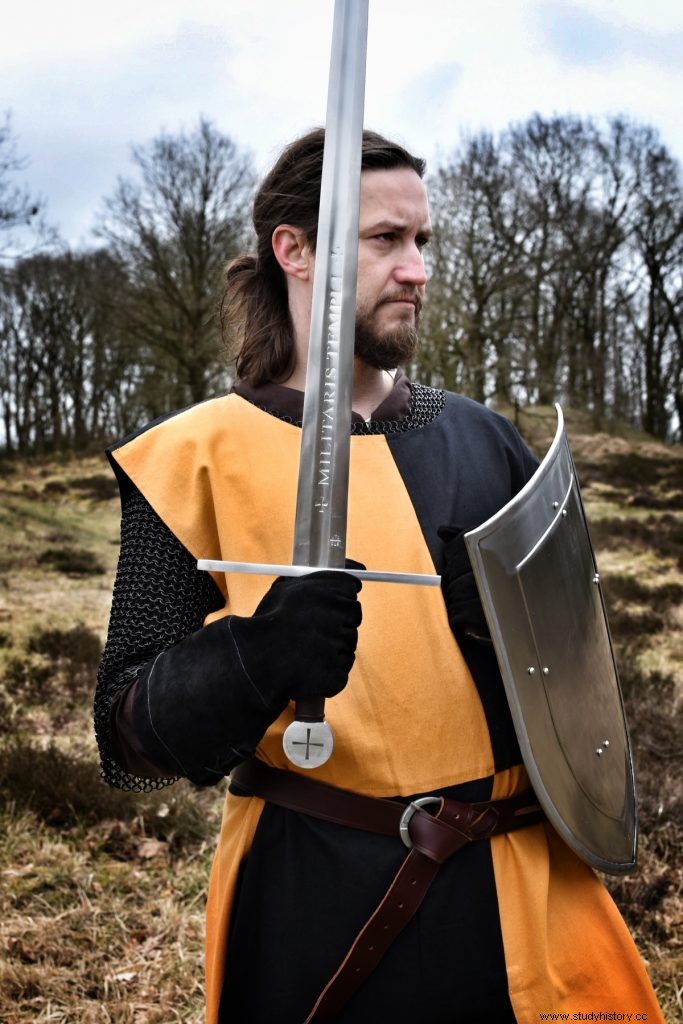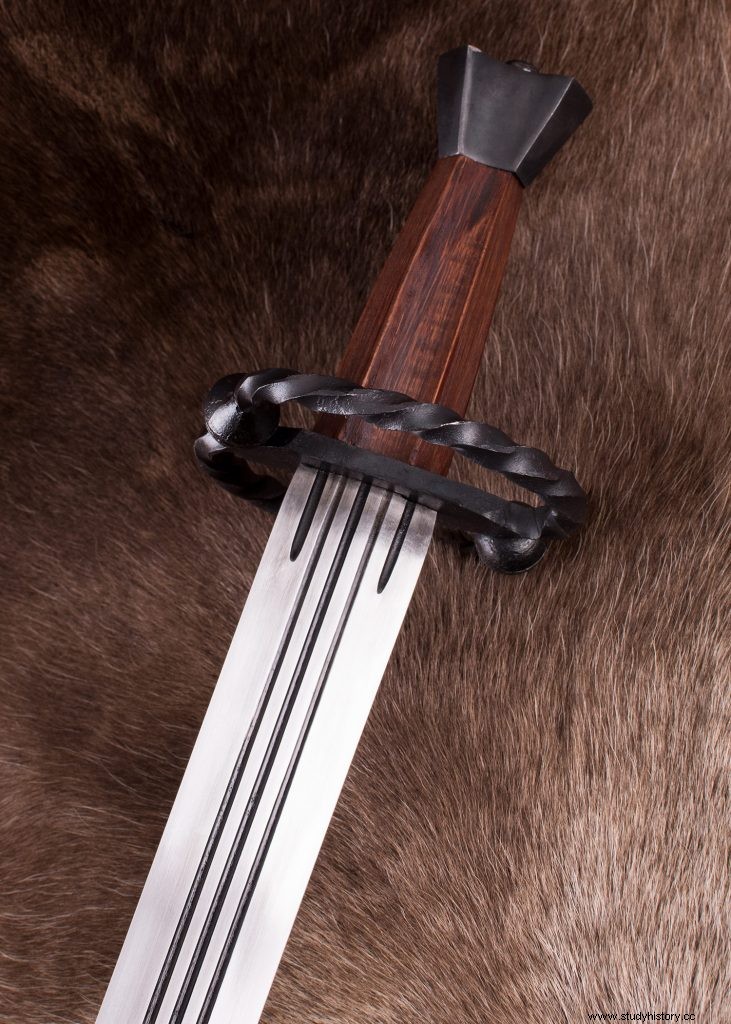In the course of European history, the sword has undergone many changes. While the swords of the La Tène period were still relatively uniform and simple, diverse and complex sword shapes developed over the centuries. The following article gives you a brief overview of the most important development stages of European swords.
Swords of the La Tène period

Iron processing had already spread rapidly in Europe during the Hallstatt period (approx. 800-450 BC). As a result, the number of iron swords increased rapidly. Despite differences in manufacturing methods and materials, the iron swords of the Hallstatt period were still very similar in shape to their bronze predecessors. However, this changed at the beginning of the La Tène period (450-100 BC)
Latène swords mostly had a thin, double-edged and straight iron blade. The length was usually between 80 and 100 cm. They were usually provided with a curved guard-like guard (see replica in the picture). This was soldered between the tang and the blade and was primarily intended to prevent the blade from being pressed into the wooden handle.
Over time, these swords developed into almost pure slashing weapons, although there were regional differences. In shape they resembled a spathe, which they are considered to be the forerunners of. In the La Tène period, the first swords with stamp marks also appeared. These could be manufacturer brands, but this has not been definitively proven.
Note on terminology: The terms Latène sword and Celtic sword are often used synonymously, although this does not always have to be the case. The La Tène period is a temporal epoch and the Celts are a cultural group. A sword can come from the La Tène period without ever having seen a Celt. Furthermore, a Celtic sword may have existed before the La Tène period, because the Celtic culture lasted from around 800 to 275 BC.
Ancient Swords
It is believed that La Tène swords were distributed in the Roman army via hired Celtic cavalry troops. She further developed the sword and the Roman spatha was born. It was between 75 and 110 cm long and had a blade 4 to 6 cm wide. It was initially used primarily by mounted auxiliary troops, but by the 2nd century at the latest it was also used in the infantry arsenal.
The Romans have been using the 50-58 cm long gladius since the 3rd century BC. This short sword had already developed within the Roman army two centuries before the introduction of the spatha from a type of sword used by the Iberian Celtiberians. The standard sword of Roman infantry for centuries, the gladius was finally largely superseded by the spatha by the 3rd century.
Unlike the Roman swords, the Gallic swords had no point. They were therefore mainly used as a cutting weapon. The Thracians and their relatives, the Dacians, brought curved swords from the eastern Black Sea region into the Roman culture. The falx was a Roman curved sword whose length could vary considerably from 50 to 130 cm. Long swords, on the other hand, were not common among the Germans. Towards the end of antiquity, only the short sword was used by the European peoples.
Swords of the Migration Period
During the Migration Period, the spatha continued to be widespread. Numerous peoples adopted the sword. The Germanic peoples in particular developed the spathe further in the period that followed, which made it longer and heavier over time. It was considered a weapon of the noble and wealthy.
In comparison, the sax, a short, single-edged slashing knife, was also made for simple domestic use. Over time, the Germans straightened the blade of the sax and made it bigger and heavier. From this development finally emerged the Scramasax, which was more like a single-edged short sword.
In the course of the Migration Period, isolated so-called "wormy blades" appeared within Europe. These were swords made of Damascus steel, which probably came to Europe through the Moorish workshops on the north-east coast of Africa.
Early Middle Ages / Viking swords
Between the 6th and 7th centuries, sword manufacture experienced a noticeable boom in large parts of Europe. The quality of the steel improved in some cases significantly. Some high-quality works, which were already equipped with shaped hollow grinds, date from this period. In addition, Syrian artisans and bladesmiths settled in Spain and Sicily in the 8th century, which led to the spread of unusually high-quality blades.
Many early medieval swords were long and wide in shape. Their tips were mostly rounded. The earlier Roman slashing and stabbing weapons had now largely developed into pure slashing weapons. The defense bars had a straight shape and were not primarily designed to protect the user's hand, but to injure the opponent. The pommel usually had a round or flattened shape.
During the Viking Age (from the 8th century) the Viking sword developed from the spatha. It was characterized u. a. characterized by a more pronounced quillons. It thus represented an intermediate step towards the development of the well-known long sword of the Middle Ages. Many of these blades also had letters inlaid in iron.
Swords in the High Middle Ages

From the 10th century, the knight's sword or long sword gradually developed from the Viking sword. Both the blades and the crossguards became longer. The average length of the blades now increased by 90-130 cm. In addition, the swords were again provided with a tip for thrusting. Due to their straight shape and long crossguards, the long swords of the High Middle Ages often resembled a Christian cross.
Towards the end of the 12th century, European longswords typically had a broad blade that became increasingly pointed, a broad, straight crossguard, and a sectioned hilt ending in a rounded or flattened pommel. In the transition to the late Middle Ages, first one-and-a-half handed swords (bastard swords) and later two-handed swords (bided hands) developed from this form.
Late medieval swords
The development towards longer and longer swords continued in the High Middle Ages. The average sword of that time had a blade 110 to 120 cm long. While one and a half handed swords were still a rarity in the 13th century, they finally developed into the characteristic knight's sword of that time in the 14th century.
As the quality and strength of armor increased, so did the blades. Hollow grinding became less common and the blades were now increasingly pointed from the tang to avoid being too heavy. This should improve the power of the slash.
In the 14th century, particularly pointed drilling swords intended for thrusting became more popular in Italy and France. Their points were extremely hard and were able to pierce mail.
Renaissance / early modern

The refinement of fencing and warfare meant that the use of the sword gradually changed. Simple crossguards have been replaced by more complex grip and knuckle guards. In the 16th century, armor piercers, which were used against heavy armor, developed from drilling swords.
Also, swords were no longer reserved for knights and nobles. Over time, more and more swords were used, especially in mercenary armies. Powerful two-handed swords with a length of 1.5 m or more developed from the hand and a half sword. From 1500 even models with a length of up to 2 m appeared. These were mainly used by Landsknechts. The short Katzbalger, with its S-shaped crossguard, also became famous as the typical Landsknecht sword of the 16th century.
